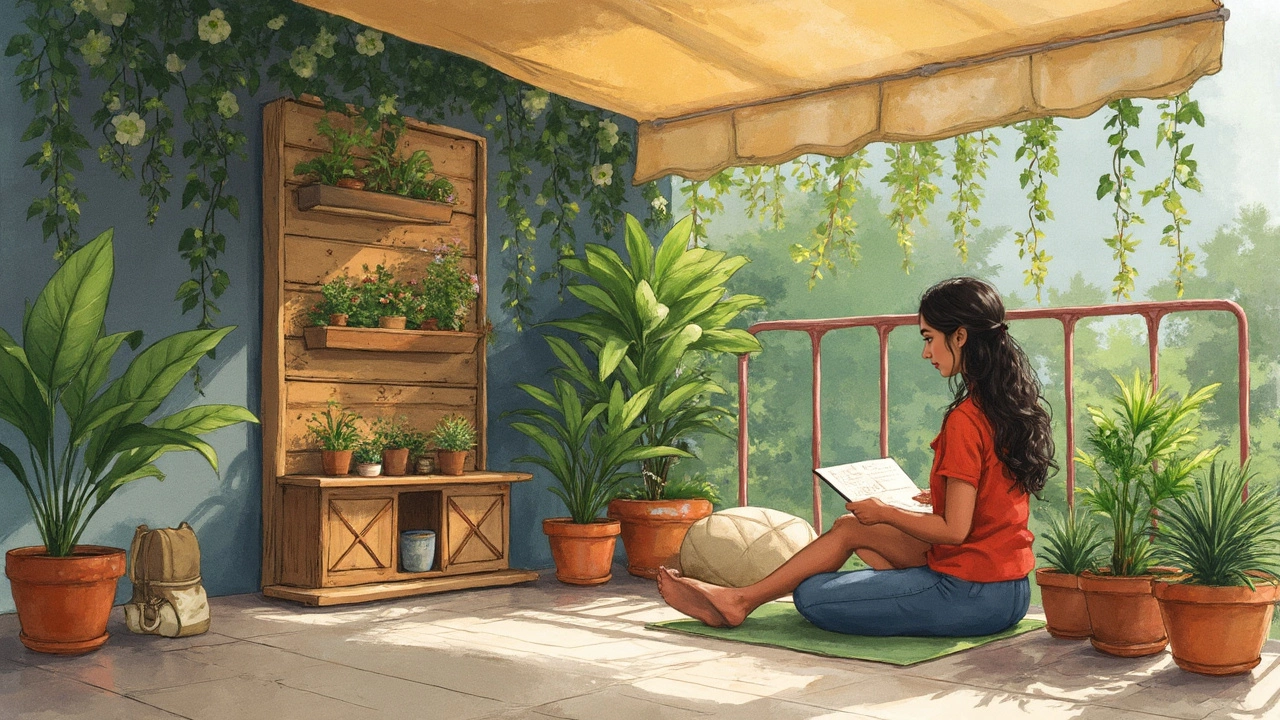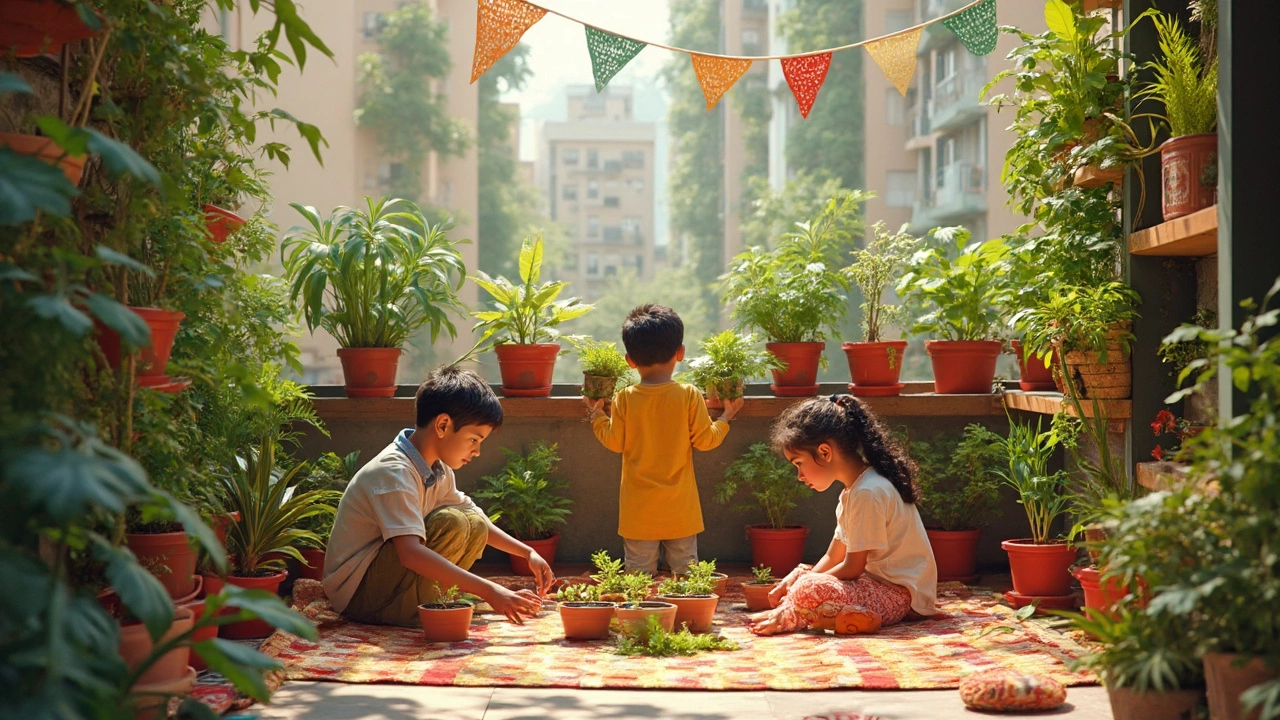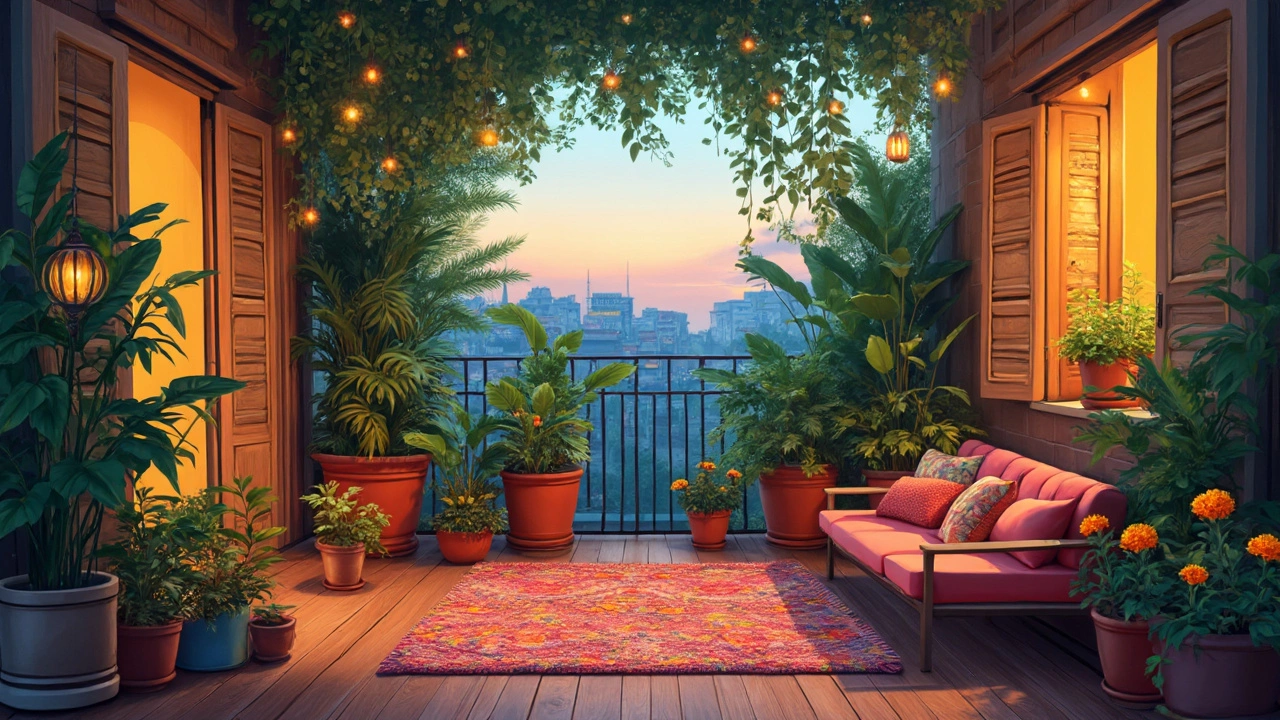Every balcony can be transformed—seriously, even that tiny ledge above a city street. Start by looking at your space and how much sun it gets during the day. Some balconies roast in sun, others feel like a shaded cave. This matters way more than you’d think. Plants react differently to light. Tomatoes need full sun, while ferns would shrivel there. So before you even buy a flowerpot, notice the light patterns—morning, noon, and evening.
Grab a measuring tape and get your balcony’s length and width. You’ll waste less money on stuff that doesn’t fit. Even a shoe-box balcony can turn cozy with the right setup. Jot down if you’ve got weight restrictions (lots of apartments do) before buying planters or furniture. These first steps help you avoid classic mistakes—like buying a giant bench you can’t even open the door with.
- Think About Space and Light
- Picking the Right Plants
- Creative Furniture and Decor Hacks
- Privacy and Comfort Upgrades
- Maintenance Made Simple
Think About Space and Light
Before you buy anything, get clear on what you’re working with. Most balconies are small. The average city balcony in the US is about 30 square feet, but tons come in at under 20. If you don’t know your exact size, break out the tape measure. Write it down and snap a quick photo. This makes shopping way easier and helps avoid surprises later.
Next up is light. Plants care a lot about sunlight, and so should you. Does your balcony face north, south, east, or west? South-facing spots usually pull in the most sun—sometimes up to eight hours a day. North-facing ones can be dim, great for shade-loving greenery. To keep it simple, here’s a quick cheat sheet:
- South-facing: Best for sun-lovers like tomatoes, basil, and succulents.
- West-facing: Hot afternoons, less morning sun. Good for heat-tough plants like peppers and marigolds.
- East-facing: Morning sun. Perfect for herbs and flowers that like things a bit softer—think mint or petunias.
- North-facing: Mostly shade. Go for ferns, ivy, or peace lilies.
Don’t just trust your gut—time the sun yourself. Take a look at your balcony every couple of hours on a day off and jot down when the light is strongest. Even a little difference can change what will thrive or barely survive.
Maximizing space is next. Use your walls—not just the floor. Hanging planters, shelving, or even a vertical garden almost triple what you can grow. If your building allows it, railing planters are clutch—no wasted space. Here’s a smart trick: foldable furniture. Tables that fold flat, stackable chairs, and slim benches let you enjoy your new balcony garden without clutter.
| Balcony Orientation | Average Daily Sunlight | Best Plant Choices |
|---|---|---|
| South | 6-8 hours | Tomatoes, Basil, Succulents |
| West | 4-6 hours (afternoon) | Peppers, Marigolds |
| East | 4-6 hours (morning) | Mint, Petunias |
| North | 2-3 hours | Ferns, Ivy, Peace Lily |
Last thing—safety. Always check weight limits if you live in an apartment. Some buildings set caps as low as 40 lbs per square foot, including people, pots, and furniture. Spread heavy planters closer to walls or corners where support is strongest.
Picking the Right Plants
Not every plant will thrive on a balcony, so don't just grab whatever looks good at the garden store. If your balcony gets five or more hours of direct sun, tomatoes, peppers, lavender, and petunias work well. Got mostly shade? Go for ferns, impatiens, or peace lilies. Most people forget herbs—stuff like basil, mint, and rosemary is perfect for pots, and you can actually use them in your kitchen.
Here’s a quick cheat sheet:
- Balcony garden with full sun: cherry tomatoes, succulents, geraniums, and chili peppers
- Shaded balconies: fuchsias, begonias, and snake plants
- Windy spots: dwarf conifers, juniper, and grasses like blue fescue
The size of your planters matters, too. Small pots dry out fast—even faster if your balcony faces south or west. Bigger pots hold moisture longer and keep your plants happier. For low-maintenance, try self-watering containers. You’ll refill them way less often, which is a lifesaver if you travel or just forget to water.
Want hanging greenery? There’s a simple trick: mix trailing plants like ivy or string of pearls with upright ones for some height variety. Vertical gardens or railing planters save space and look Instagram-worthy—just double-check your railing can handle the weight.
Real talk: plants need the right soil to thrive. Balcony setups usually do best with bagged potting mix, not dirt straight from the ground. Potting mix stays lighter and drains better, which keeps roots happy. And watch out for drainage holes, or you’ll have swampy roots in no time.
"Container gardening makes it possible for anyone to grow their own food or create beauty, even without a backyard. With the right plants and a little planning, a balcony can be as lush as any garden." — The Royal Horticultural Society
Here’s some useful data to help you plan:
| Plant Type | Light Requirement | Recommended Pot Size |
|---|---|---|
| Tomato | Full Sun | 15+ liters (4+ gallons) |
| Fern | Shade/Partial Shade | 5-10 liters (1-2.5 gallons) |
| Mint | Partial Sun | 3-5 liters (0.7-1.3 gallons) |
| Geranium | Full Sun | 2-3 liters (0.5-0.8 gallons) |
Test a few combos, keep an eye on how things grow, and don’t be afraid to swap plants around as you learn what works best for your space.

Creative Furniture and Decor Hacks
If you want a balcony that's actually usable (and not just nice to look at), it’s all about smart furniture solutions and personal touches. Start with foldable chairs and tables—they’re life-savers for small space gardening. IKEA claims their ÄPPLARÖ balcony table is one of the best-sellers each year, mostly because you can fold it down and free up space in seconds. No room for a regular seat? Try a hanging balcony rail table that snaps onto the railing—great for enjoying your coffee without taking up extra floor area.
Don’t ignore vertical space. Install wall-mounted shelves or hang planter pockets to stack your greens up instead of spreading them out. This lets you fit twice as many plants or even squeeze in a lantern or fairy lights for the evenings. For storage, try benches with a hidden compartment underneath—good for hiding tools, cushions, or extra soil bags so your area doesn’t turn into a clutter factory.
- Mix and match textiles—use outdoor pillows and rugs to soften things up. Go for easy-clean fabrics so you don’t stress about summer thunderstorms.
- String lights or solar lanterns seriously level up the mood, especially if you like to hang out after sunset.
- Got an ugly floor? Snap-on deck tiles (the kind you click together without tools) can totally change the whole vibe in under an hour.
For renters, look for items that need zero drilling. Think adhesive hooks, freestanding shelves, or even an outdoor cart you can wheel in and out. If you’re picky about color, cheap spray paint can totally flip old metal furniture or clay pots without blowing the budget.
| Item | Percentage of Balcony Owners Who Use |
|---|---|
| Foldable Chairs/Tables | 67% |
| String/Solar Lights | 58% |
| Snap-on Deck Tiles | 41% |
| Hanging Planters/Shelves | 53% |
| Outdoor Rugs | 38% |
Balance comfort and space, and don’t be afraid to mess around with the setup until it actually works for you. Your balcony should be a chill spot that fits your life, not just some Pinterest dream.
Privacy and Comfort Upgrades
No one wants to relax outside while feeling like a fish in a bowl. Privacy makes a massive difference when you’re setting up a balcony garden. The cool thing? Even on a budget, there are plenty of ways to get that cozy, tucked-away vibe.
Tall plants are your new best friends. Bamboo grows fast, looks great, and is perfect for screening. Just go for clumping bamboo so it doesn’t take over. Tall grasses like miscanthus or a row of potted evergreens can do the job too. You’ll get some greenery and block out nosey neighbors at the same time.
Removable screens or trellises are easy wins for renters. There’s a big trend right now with roll-up bamboo shades, mesh privacy screens, or foldable wooden slats. Most options attach with zip ties or hooks and won’t mess with your deposit. If you love a bit of DIY, hang weatherproof curtains with tension rods for a breezy, flexible wall.
Alright, on to comfort. You shouldn’t sit on metal chairs that feel like ice in winter or fire in summer. Go for weather-resistant cushions and add a compact outdoor rug. Textiles not only make things more comfy but also soak up some street noise. Speaking of noise, if your balcony faces a busy road, a water feature or small fountain will help mask traffic sounds (indoor tabletop fountains work outside too).
If you want to use your balcony year-round, grab a patio heater or a string of outdoor-safe fairy lights for warmth and mood. Solar-powered lights are getting cheaper and brighter, so you won’t rack up an electric bill. And don’t forget shade: a simple umbrella or shade sail blocks harsh midday sun and keeps your plants from frying.
| Privacy Solution | Ease of Setup | Cost Range |
|---|---|---|
| Bamboo Screens | Easy | $30–$100 |
| Tall Potted Plants | Medium | $25–$120 |
| Outdoor Curtains | Easy | $25–$60 |
| Mesh/Fabric Screens | Very Easy | $10–$40 |
| Wooden Slat Panels | Medium | $50–$150 |
Bottom line: mix and match until your balcony feels private and actually inviting, not just functional. Small upgrades add up, and you’ll end up with a spot you actually want to hang out in—not just glance at through your window.

Maintenance Made Simple
No one wants to spend their weekends cleaning messes and rescuing dying plants. The trick to keeping a balcony garden looking good? Smart, simple routines and the right gear.
Watering is the first thing that can get out of hand, especially if you’re juggling work and life. Go for self-watering planters or add a cheap drip irrigation kit. These setups keep your plants happy even if you skip a day or two. If you travel, a simple water globe can save your green friends from a heatwave dry-out.
Cleaning up is way easier when you pick compact tools. A foldable broom, handheld dustpan, and a bucket that tucks under a chair are all you need. Don’t overlook balcony floors—rough tiles trap soil and water. Consider interlocking deck tiles that lift up so you can rinse underneath every few weeks. Here’s how long some tasks really take if you keep it basic:
| Task | Time per Week |
|---|---|
| Watering | 10-15 mins |
| Wiping Railings/Furniture | 5 mins |
| Checking plants for pests | 3 mins |
| Sweeping or Rinsing Floor | 10 mins |
A little weekly TLC keeps your balcony tidy. Electronic plant monitors and weather apps can save you from guessing if it’s time to water or not. Don’t want bugs? Keep saucers empty and clear away fallen leaves. Tough plants like succulents, snake plants, and geraniums don’t need much fussing—good if you’re a set-and-forget type.
Mulch makes a huge difference. Simple bark or pebble mulch will slow down evaporation, hold back weeds, and keep things neat. And if you ever get a big mess—mud, spilled soil, or bird droppings—old towels and a spritz bottle are your new best friends.

